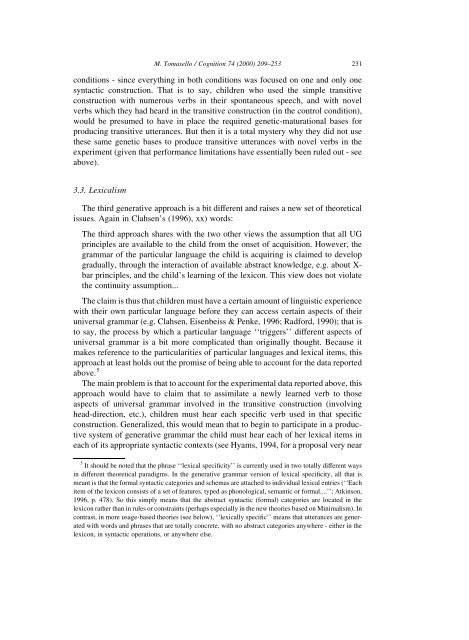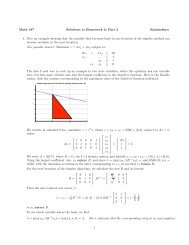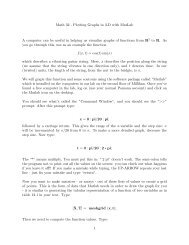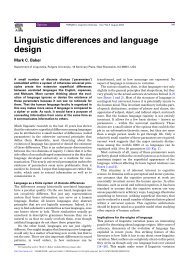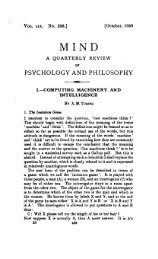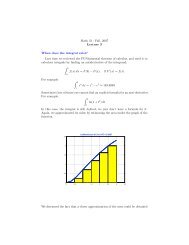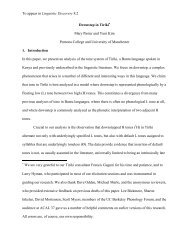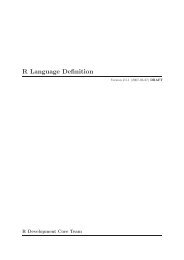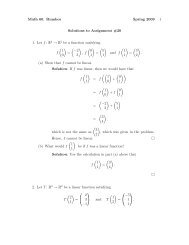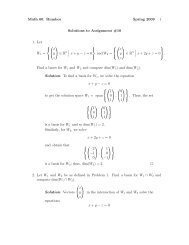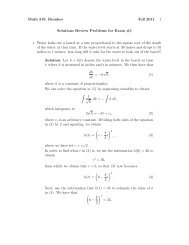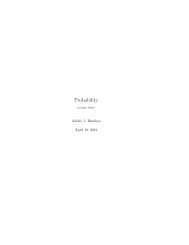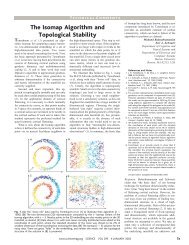Tomasello
Tomasello
Tomasello
You also want an ePaper? Increase the reach of your titles
YUMPU automatically turns print PDFs into web optimized ePapers that Google loves.
M. <strong>Tomasello</strong> / Cognition 74 (2000) 209±253 231conditions - since everything in both conditions was focused on one and only onesyntactic construction. That is to say, children who used the simple transitiveconstruction with numerous verbs in their spontaneous speech, and with novelverbs which they had heard in the transitive construction (in the control condition),would be presumed to have in place the required genetic-maturational bases forproducing transitive utterances. But then it is a total mystery why they did not usethese same genetic bases to produce transitive utterances with novel verbs in theexperiment (given that performance limitations have essentially been ruled out - seeabove).3.3. LexicalismThe third generative approach is a bit different and raises a new set of theoreticalissues. Again in Clahsen's (1996), xx) words:The third approach shares with the two other views the assumption that all UGprinciples are available to the child from the onset of acquisition. However, thegrammar of the particular language the child is acquiring is claimed to developgradually, through the interaction of available abstract knowledge, e.g. about X-bar principles, and the child's learning of the lexicon. This view does not violatethe continuity assumption...The claim is thus that children must have a certain amount of linguistic experiencewith their own particular language before they can access certain aspects of theiruniversal grammar (e.g. Clahsen, Eisenbeiss & Penke, 1996; Radford, 1990); that isto say, the process by which a particular language ``triggers'' different aspects ofuniversal grammar is a bit more complicated than originally thought. Because itmakes reference to the particularities of particular languages and lexical items, thisapproach at least holds out the promise of being able to account for the data reportedabove. 5The main problem is that to account for the experimental data reported above, thisapproach would have to claim that to assimilate a newly learned verb to thoseaspects of universal grammar involved in the transitive construction (involvinghead-direction, etc.), children must hear each speci®c verb used in that speci®cconstruction. Generalized, this would mean that to begin to participate in a productivesystem of generative grammar the child must hear each of her lexical items ineach of its appropriate syntactic contexts (see Hyams, 1994, for a proposal very near5 It should be noted that the phrase ``lexical speci®city'' is currently used in two totally different waysin different theoretical paradigms. In the generative grammar version of lexical speci®city, all that ismeant is that the formal syntactic categories and schemas are attached to individual lexical entries (``Eachitem of the lexicon consists of a set of features, typed as phonological, semantic or formal....''; Atkinson,1996, p. 478). So this simply means that the abstract syntactic (formal) categories are located in thelexicon rather than in rules or constraints (perhaps especially in the new theories based on Minimalism). Incontrast, in more usage-based theories (see below), ``lexically speci®c'' means that utterances are generatedwith words and phrases that are totally concrete, with no abstract categories anywhere - either in thelexicon, in syntactic operations, or anywhere else.


